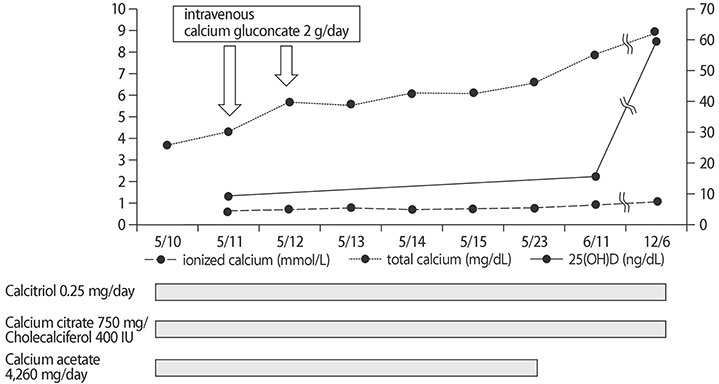Electrolyte Blood Press.
2019 Jun;17(1):21-24. 10.5049/EBP.2019.17.1.21.
Severe Hypocalcemia in a Patient with Tuberous Sclerosis Complex
- Affiliations
-
- 1Department of Internal Medicine, Seoul National University Bundang Hospital, Seongnam, Korea. mednep@snubh.org
- 2Department of Internal Medicine, Seoul National University College of Medicine, Seoul, Korea.
- KMID: 2451518
- DOI: http://doi.org/10.5049/EBP.2019.17.1.21
Abstract
- Tuberous sclerosis complex (TSC) is an autosomal dominant genetic disorder affecting multiple organs, including the brain, skin, lung, and kidney. Among the multiple comorbidities in TSC, bone mineral disturbances remain relatively unrecognized, and only a few studies have reported alteration in calcium homeostasis. Hypocalcemia is a serious medical condition in patients with TSC who are at high risk for seizures. Therefore, hypocalcemia should be thoroughly evaluated by obtaining a history of associated medication use and measuring vitamin D levels. Here, we report the case of a patient with TSC who presented with severe hypocalcemia which may have been related to a history of anticonvulsant use and a recent decline in kidney function, and was successfully treated with calcium and vitamin D replacement.
MeSH Terms
Figure
Reference
-
1. Lam HC, Siroky BJ, Henske EP. Renal disease in tuberous sclerosis complex: pathogenesis and therapy. Nat Rev Nephrol. 2018; 14:704–716.
Article2. Hallett L, Foster T, Liu Z, Blieden M, Valentim J. Burden of disease and unmet needs in tuberous sclerosis complex with neurological manifestations: systematic review. Curr Med Res Opin. 2011; 27:1571–1583.
Article3. Curatolo P, Bombardieri R, Jozwiak S. Tuberous sclerosis. Lancet. 2008; 372:657–668.
Article4. Bissler JJ, Christopher Kingswood J. Renal manifestation of tuberous sclerosis complex. Am J Med Genet C Semin Med Genet. 2018; 178:338–347.
Article5. Amin S, Lux A, Calder N, Laugharne M, Osborne J, O'Callaghan F. Causes of mortality in individuals with tuberous sclerosis complex. Dev Med Child Neurol. 2017; 59:612–617.
Article6. Kingswood JC, Bissler JJ, Budde K, Hulbert J, Guay-Woodford L, Sampson JR, et al. Review of the tuberous sclerosis renal guidelines from the 2012 consensus conference: current data and future study. Nephron. 2016; 134:51–58.
Article7. Rado JP, Haris A. Metabolic bone disease (anticonvulsant osteomalacia) and renal tubular acidosis in tuberous sclerosis. Intern Med. 1993; 32:574–579.
Article8. Randle SC. Tuberous sclerosis complex: a review. Pediatr Ann. 2017; 46:e166–e171.
Article9. Mortensen LS, Rungby J. Tuberous sclerosis and parathyroid adenoma. J Clin Pathol. 1991; 44:961–962.
Article10. Nseir G, Golshayan D, Barbey F. Phenytoin-associated severe hypocalcemia with seizures in a patient with a TSC2-PKD1 contiguous gene syndrome. Ren Fail. 2013; 35:866–868.
Article11. Okada K, Kuno T, Shimada A, Satou M, Inoue M, Tochihara T, et al. A maintenance hemodialysis patient with tuberous sclerosis presenting as severe hypocalcemia. Nihon Jinzo Gakkai Shi. 1986; 28:1545–1552.12. Henske EP, Jozwiak S, Kingswood JC, Sampson JR, Thiele EA. Tuberous sclerosis complex. Nat Rev Dis Primers. 2016; 2:16035.
Article13. Grober U, Kisters K. Influence of drugs on vitamin D and calcium metabolism. Dermatoendocrinol. 2012; 4:158–166.
Article14. Kulak CA, Borba VZ, Bilezikian JP, Silvado CE, Paola L, Boguszewski CL. Bone mineral density and serum levels of 25 OH vitamin D in chronic users of antiepileptic drugs. Arq Neuropsiquiatr. 2004; 62:940–948.
Article15. Levin A, Bakris GL, Molitch M, Smulders M, Tian J, Williams LA, et al. Prevalence of abnormal serum vitamin D, PTH, calcium, and phosphorus in patients with chronic kidney disease: results of the study to evaluate early kidney disease. Kidney Int. 2007; 71:31–38.
Article16. Brandi ML, Bilezikian JP, Shoback D, Bouillon R, Clarke BL, Thakker RV, et al. Management of hypoparathyroidism: summary statement and guidelines. J Clin Endocrinol Metab. 2016; 101:2273–2283.
Article17. Kurokawa K. Calcium-regulating hormones and the kidney. Kidney Int. 1987; 32:760–771.
Article18. Pires A, Sobrinho L, Ferreira HG. The Calcium/phosphorus homeostasis in chronic kidney disease: from clinical epidemiology to pathophysiology. Acta Med Port. 2017; 30:485–492.
Article
- Full Text Links
- Actions
-
Cited
- CITED
-
- Close
- Share
- Similar articles
-
- Tuberous Sclerosis with Aortic Aneurysm and Rib Changes
- Everolimus Treatment and Follow-up in an Infant with Neurological Complication Associated with Tuberous Sclerosis Complex
- Clinical observation on tuberous sclerosis
- A Case of Tuberous Sclerosis Complex Developing with Subependymal Giant-Cell Astrocytoma and Hydrocephalus
- A Case of Tuberous Sclerosis with Hemimegalencephaly



